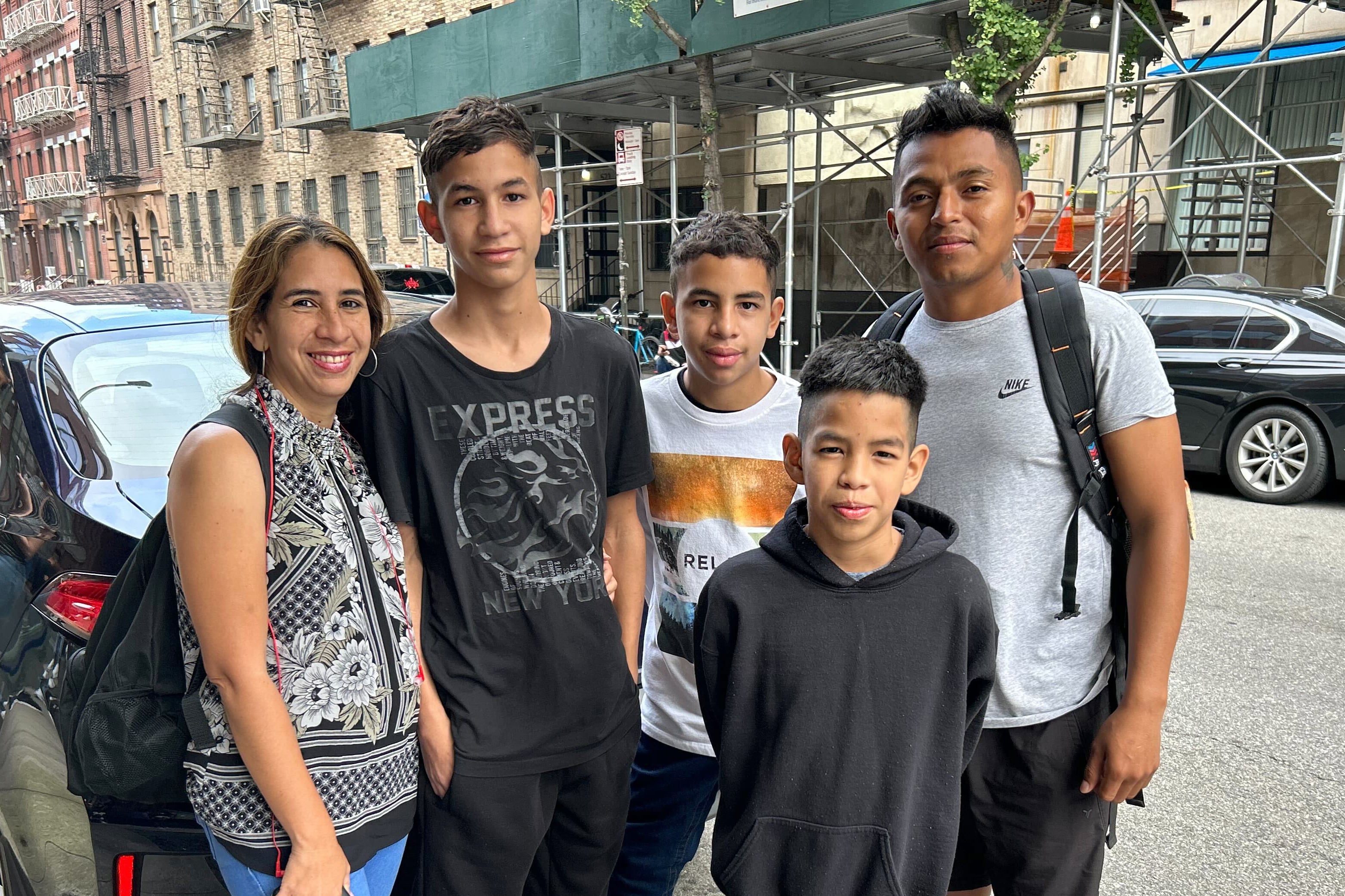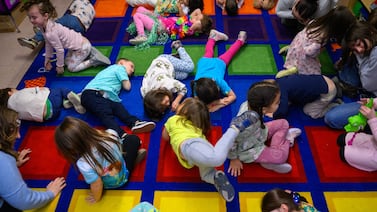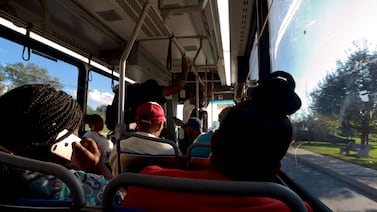Sign up for Chalkbeat New York’s free daily newsletter to keep up with NYC’s public schools.
As scores of asylum-seeking families continue arriving in New York City, the city’s efforts to quickly enroll their children in public schools are often failing to keep pace, according to families, advocates, and education department staffers.
The mammoth task of managing the new arrivals’ school enrollment has been hampered by insufficient staffing, inexperienced shelter operators, and gaps in language access, people familiar with the process said.
That’s left some families waiting weeks for school placements or without seats at all yet, sparking concerns that some kids won’t have their school plans finalized by the start of classes on Sept. 7, and that schools won’t have adequate time to prepare for new students before the year begins.
“Even prior to all this there was a tremendous need” for education department staffers working directly in homeless shelters to help families with school-related issues, said Jennifer Pringle, a project director at Advocates for Children, an organization that advocates for children in shelters, among other groups.
Advocates for Children had pushed the education department to hire 150 full-time shelter-based staffers before the influx of asylum seekers began, and last year, the city committed to hiring 100. But advocates say that number is insufficient to address the current needs.
“You’ve opened dozens and dozens of new shelters with no additional staff,” Pringle said. “To me, it’s utterly not surprising that there are enrollment delays, and in fact, I would be shocked if there weren’t.”
New shelters spark staffing concerns
More than 100,000 asylum seekers have arrived in New York City since last summer, with many taking residence in a rapidly expanding network of homeless shelters. An estimated 19,000 children so far have enrolled in the city’s public schools, with around 500 registering since July, according to an Education Department spokesperson.
The volume of the influx has sparked dire warnings from Mayor Eric Adams, who has said that city services are strained to capacity and that the city needs additional help from the state and federal governments.
Job one for the Education Department is identifying the new arrivals and getting them appropriate school placements – meaning, among other things, that the family has a way to get there and the school offers the necessary language support.
Staffers from the department’s division of students in temporary housing, including the 100 community coordinators hired last year, are tasked with fanning out to shelters, talking to the new arrivals about school enrollment, and helping them fill out registration forms, which are then delivered to the Education Department’s family welcome centers.
But a staffer involved with the process said employees are struggling to keep up with the ever-increasing number of shelters and new arrivals.
“They don’t have enough staff, they’re working like dogs, and it’s a bit of a disaster,” the staffer said.
In some cases, single employees are covering multiple shelters at once, handling case loads of between 250 and 500 kids, the employee said.
“The number of people is outrageous,” the staffer said. “There are so many children. If you go into a shelter … and the family is out that day, you don’t get registered. … Those kids are getting missed.”
Another roadblock is that many of the new emergency shelters the city has opened to accommodate the influx are operated by relatively new providers without experience helping families with school sign-ups.
“I just think everyone is stretched really thin, there’s a lot of new kids on the block … and in the meantime, children and families are not going to have the experience we believe they should,” said Catherine Trapani, the executive director of Homeless Services United, a coalition of 50 of the city’s long-running homeless shelter operators.
Dan Weisberg, the first deputy chancellor of the Education Department, said enrollment for the new arrivals has generally “gone smoothly.”
But he acknowledged the speed at which the city has had to open new family shelters has been “challenging. It means that we then have to scramble to assign somebody to go talk to the families about enrollment. So as long as that dynamic is happening … it will take a little longer for us to get help there.”
Education Department spokesperson Nicole Brownstein said “Project Open Arms,” a blueprint released last year for educating migrant children that emphasized interagency communication, remains in effect.
Families face waits for school placements
Norberto Priceño arrived from Venezuela in June with his wife and three children, and the family has been living in a shelter in Far Rockaway, Queens. Priceño said he’s received virtually no information from the shelter staff about how to access city services, and only found out how to enroll his kids in school from other families in the shelter.
He took his kids to a family welcome center last month and was told he’d hear back about school placements in 15 days, but so far has only gotten confirmation that one of his kids is registered.
“School starts next week, and we only have one confirmed to start school, we haven’t gotten an answer for the other two,” he said. “I’m worried for their education,” he added, noting that he doesn’t want any of his kids to miss class time.
One staffer at a family welcome center, who declined to give her name, said that enrollment with the new arrivals is proceeding as normal and that families generally only have to wait 24-48 hours.
But another agency staffer involved with enrollment said the wait times for the newly arrived families have been significantly longer this summer than in past years, sometimes taking several weeks.
An Education Department spokesperson said that the average turnaround time is about a week, and that the agency makes sure enrollment letters are sent directly to families at shelters, so they don’t have to return to the family welcome centers.
Deputy Chancellor Carolyne Quintana said staffers from the Education Department’s multilingual division and other central offices have been posted at family welcome centers throughout the summer to lend additional support.
Even after enrollment assignments are confirmed, some newly arrived families are still struggling to figure out how to make the school placements work.
Jenny Lozano and Andres Yara are Colombian immigrants who arrived earlier this summer and have been living at a shelter in midtown Manhattan — where the family of four is currently sharing one queen-sized bed. They said they had to wait about a month after first handing in their form to get a school placement for their 12-year-old daughter.
When they finally got their daughter’s school assignment, it was a school in Harlem roughly 80 blocks away from their shelter. Lozano said she was told that because of all the new arrivals, schools closer to her shelter were all full.
Younger students living in shelters are eligible for yellow buses if their schools are far enough away, but that access ends after sixth grade, just shy of covering Lozano’s daughter. Lozano is fretting about sending her daughter on the subway in a new city and country.
“She’s too small to send her alone on the train,” Lozano said.
Language gaps persist
Some advocates say the city is especially ill-equipped to work with the increasing number of families whose languages aren’t as commonly spoken in the city as Spanish.
Arash Azizzada, the founder of Afghans for a Better Tomorrow, which supports Afghan immigrants and refugees, said many of the Farsi- and Pashto-speaking families he works with have lots of questions about how to enroll kids in school, and are often going weeks without support at shelters.
“They aren’t pivoting fast enough to accommodate this population,” he said.
Trapani said staffers in her coalition of shelter operators use a city-contracted translation phone service, but often experience long waits and don’t have printed materials they can distribute to families who speak languages not included in the city’s list of the 10 most-spoken dialects.
It’s not just families affected by enrollment delays. Schools need as much lead time as possible to plan for students, especially if they want to take advantage of the precious few days with staff in school before students arrive. Any lags in the enrollment process could undermine schools’ planning efforts, advocates warned.
“We need clear data about where the asylum seekers are going to be concentrated so that those schools can get ready now,” said Dia Bryant, the executive director of Ed Trust-New York. “It’s not going to be enough in two weeks to say, ‘Oh no, this school has 60 asylum seekers.’ We need support with actually assessing their strengths and thinking about how to support their families.”
Michael Elsen-Rooney is a reporter for Chalkbeat New York, covering NYC public schools. Contact Michael at melsen-rooney@chalkbeat.org.







